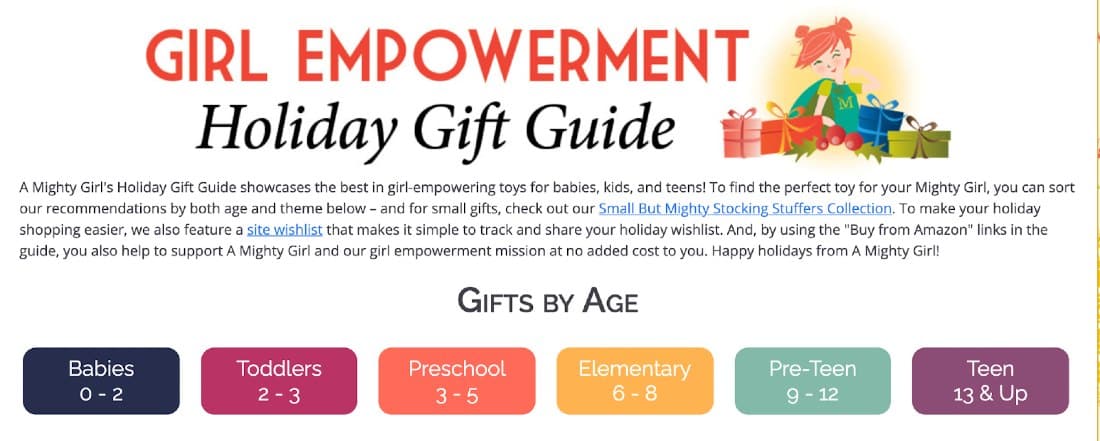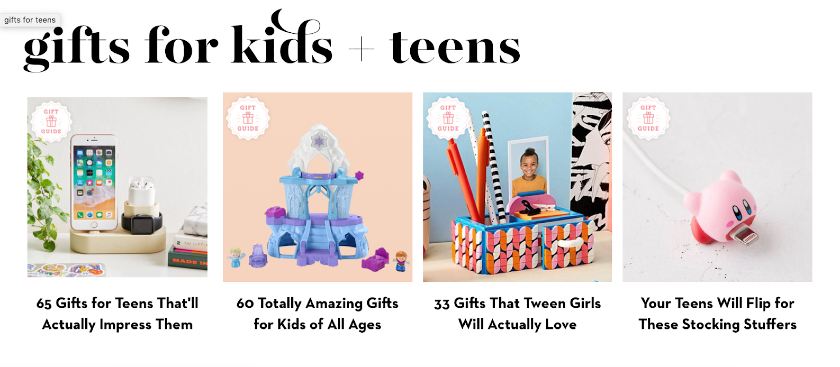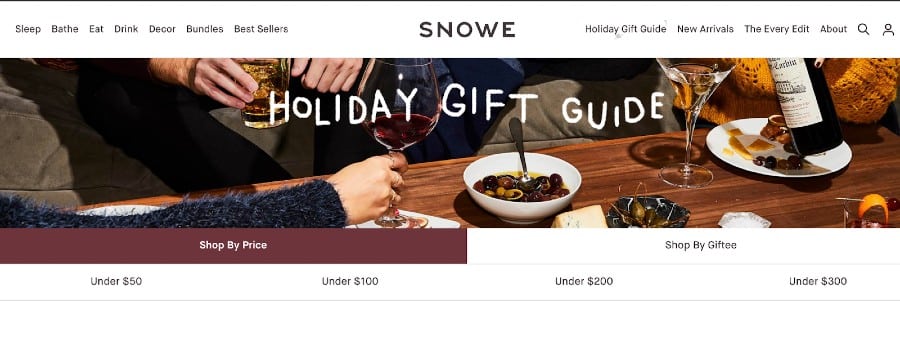Creating a holiday gift guide is essential for maximizing sales and offering great deals. Despite inflation concerns, consumer spending is still strong this season. However, 75% of shoppers are looking for deals more cautiously for the 2023 holidays—making it more important than ever to learn how to create a retail gift guide.
To create holiday gift guides, identify your target market and tap into your retail data, industry trends, and customer insights. Then, curate and categorize products, pick a format, and design it for distribution. Follow this up with marketing campaigns to ensure your gift guide is seen by the right people. Lastly, make sure to offer different ways to fulfill your holiday orders.
Let’s walk through the steps in detail below:
Step 1: Determine Your Audience
Before creating your guide, first identify and understand your target audience’s needs. From there, you can focus on smaller customer segments and consider how they search and discover gift guides.
Consider both your target audience and those purchasing gifts for them when creating a holiday gift guide.
Collect Demographic & Behavioral Data
Your point-of-sale (POS) system is a valuable source of demographic data, such as a customer’s age, gender, occupation, and geographic location. If you know which groups to target, you can plan your gift guides accordingly.
For example, you can see which gender and age group shops in-store more often. Meanwhile, if you have an online shop, knowing the locations you ship to lets you create specific promotions for them (such as free shipping on minimum spend).
Apply Customer Segmentation
Another way you can identify your target audience is by segmenting existing customers into categories (like repeat or one-time buyers) and analyzing their purchase types and spending habits. From there, you can create a gift guide by price or product type. POS systems with advanced reporting capabilities can generate sales reports according to customer category.
Step 2: Choose Products
After identifying your target audience, the next step is choosing products to include in your gift guides. There are different ways to approach this, but we recommend mixing all the approaches we discuss below.
Review Your Store’s Sales Data
Look at your retail analytics, such as sell-through and conversion rates, as it will help you make strategic decisions about product inclusions. Make sure to review your store’s bestsellers, especially those purchased during last year’s holiday season.
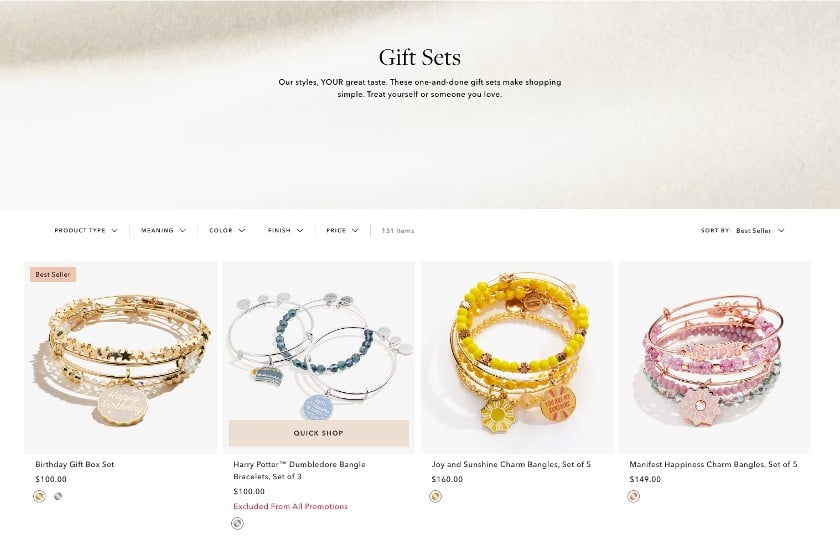
Jewelry brand Alex and Ani’s website has a Gifts category in its main menu. From here, you can shop gift sets with the bestselling items listed first.
Identify Shopping Trends
It’s also important to look at external data, such as industrywide shopping trends. Understanding what’s trending in your market lets you create holiday gift guides that are relevant and broadly appealing. Google Trends is a great tool to identify emerging opportunities in your niche and beyond.
For example, if gift cards are popular these days, consider offering them at different price points. If essential oils are trendy, consider adding them to one of your gift bundles.
Involve Your Team
Your sales associates are an invaluable source of information. They usually have firsthand knowledge of your customer’s buying behaviors and preferences. Don’t forget to gather their insights on which products to include in your gift guide. They can also help you identify cross-selling opportunities that you can apply toward gift bundle creations.
Ask Your Suppliers
If you source products from different suppliers, ask them about their top-selling items this season. This helps you plan your inventory and also check how quickly they can restock if you run out. Based on this, you can fine-tune your order quantities, considering product popularity and restock speeds.
Ask Your Customers
Directly asking customers what kind of gifts they’re looking to buy this season (or which gifts they’d like to receive) is an effective way to learn how to create a retail gift guide that appeals to them. You can use any of these strategies to gather customer insights:
- Do an in-store or online survey. A great customer engagement tip is to place a survey kiosk next to the register or exit when doing in-store surveys. You can also do a feedback survey in digital receipts for a low-cost and touch-free option. Systems like Square offer these feedback collection tools for free (read our Square review for more info).
- Run polls on social media. If your business has a strong social media following, consider running polls on your platforms. Take, for example, hand-crafted cosmetics brand Karla Cosmetics. It asks its followers what product they would love to see them create next.
Alternatively, if you’re considering adding a particular item to your gift guide, try posting an image of it on Facebook and Instagram, then gauge how your customers react.
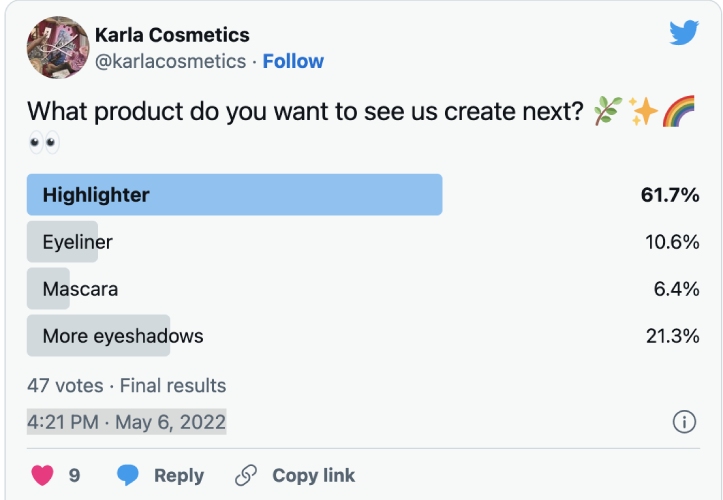
You can do a similar poll for your gift guides. Create a poll listing some of your products and ask people to vote on which items would make for great gifts.
Step 3: Categorize Your Guides
Once you have identified your target audience and the types of products you’ll include in your holiday gift guides, the next step is planning how to organize them. Ideally, we recommend creating different categories based on price, interests, personality, shopping behavior, and preferences.
When categorizing gift guides, make sure that titles are unique and instantly convey a solution to a shopper’s pain point. For example, “Gifts for Mom” or “Gifts for The One Who Has Everything” are catchy phrases that tell shoppers right away which recipients the guide is for.
Here are a few ways you categorize your lists when planning how to create a retail gift guide:
You can help a lost shopper find just the right present for their school-age nephew or elderly aunt by segmenting your gift guides by age. Using age as a gift guide category is especially helpful for shoppers searching for age-appropriate products for children. You can also broaden your categories into babies, toddlers, teens, and adults.
Retailers will often have gift guides “for him,” “for her,” or “for baby.” However, a unique approach is to go beyond “women,” “men,” and “babies” and group people into those who are more specific or harder to shop for, such as teachers, bosses, and co-workers.

Macy’s makes it easy to find gifts specific to people shoppers usually give presents to during the holidays. The brand was wise to include popular Christmas party activities White Elephant and Secret Santa.
Holiday gift guides organized by price are appealing to customers who shop with a specific budget in mind, so offer a variety of price points. While many gravitate toward lower-priced categories, don’t forget to include a category for those looking to splurge. Be creative in naming them, such as “budget,” “special,” and “extravagant.”
By listing guides by price, you help make purchasing decisions easier for shoppers because they don’t have to calculate or guess how much they’re spending for a person’s gift—and, in turn, help you sell more.
You can also categorize your products based on the recipient’s hobbies or personality, especially if you offer a wide range of merchandise. Gift guides such as “gifts for knitters,” “gifts for those who work from home,” or “gifts for the fitness enthusiasts” are great examples.
This type of category works even better if your shop caters to a specific market. For example, a store that sells cooking equipment can put out gift guides such as “gifts for those who don’t cook” and “gifts for the chef who loves gadgets.”
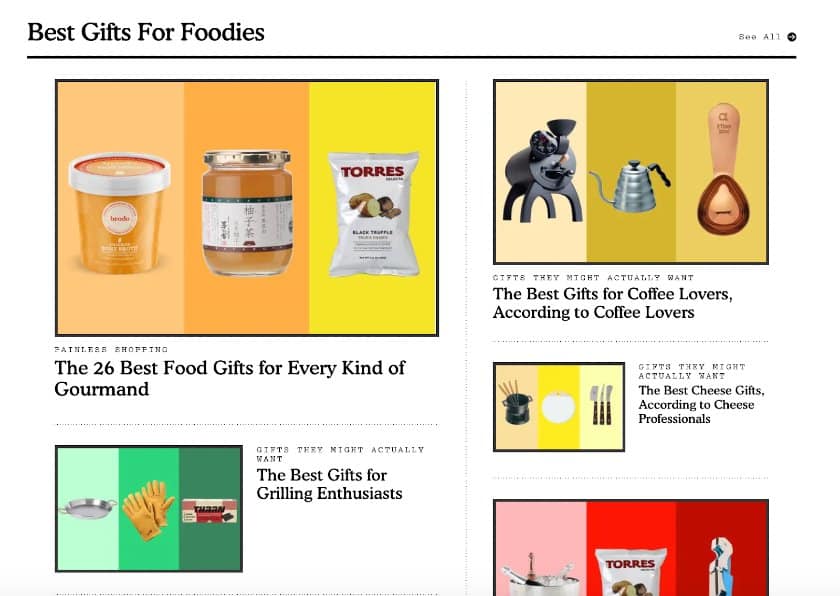
The Strategist came up with different gift guides based on recipients’ personalities, hobbies, and shopping behavior.
We particularly recommend mixing these segments and strategizing how to create a retail gift guide that’s more personal. Once you have selected your products, you can mix and match lists. For example, a crafts store could market knitting sets in lists targeted toward “crafters” (personality) and “under $20” (price).
Take it a step further by creating gift bundles within each gift guide category. Getting a bundle of items that complement each other is a type of cross-selling idea but offered at one retail price. This makes the buying decision faster, easier, and more convenient.
Make it more irresistible by offering it a lower price than when buying each separately. 22% of shoppers cite sales or discounts as the factor most influencing their holiday shopping.
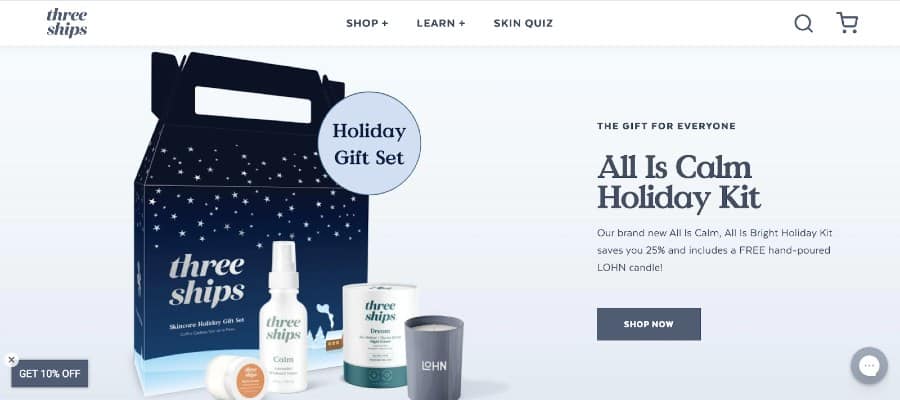
Three Ships displays a gift bundle right on its homepage header, highlighting that customers save 25% and get a free item when purchasing the gift bundle.
TIP:
- Don’t forget last-minute shoppers! Even if 43% of holiday shoppers say they shop earlier, 20% of shoppers don’t start until December. Try creating a list of “best all-around gifts” and “top last-minute gifts”.
- Suggest your gift cards for the easiest purchase of all. More than 20% of last-minute holiday shoppers resorted to buying gift cards as presents last year. Promote gift cards when creating a holiday gift guide to help them easily find the perfect gift.
Step 4: Pick a Format
As you get further in planning how to create a retail gift guide, the next step is determining the best format.
There are many gift guide formats, such as online catalogs, blog posts, printed guides for in-store distribution, printed flyers or brochures for direct mail, landing pages, social media posts, and videos. You can also include your gift guides in your holiday display ideas.
Deciding which content format to use for gift guides depends on the following factors:
- Your audience: Find out where your target audience usually looks for holiday shopping gift ideas, whether it’s social media, trustworthy blogs, magazines, flyers, or other sources.
- The platforms where you will market your gift guide: If you’re creating a holiday gift guide selection in-store, it is better to design posters for display and distribution. However, if you plan to push your gift bundles through your email list, a dedicated landing page in your ecommerce store would be a better fit.
- Your niche or industry: If you’re in a visual niche, your gift guide may not need as much text as one in a niche where information plays a more significant role in driving conversions. In this case, you might need to exert more effort in a holiday display in-store or have an excellent curation of photos for a catalog.
Your customers will likely view your gift guide on different channels or platforms, so you’ll want to make sure that your guide looks great no matter what.
Here are our suggestions based on the content format you will be going with.
In a primarily digital world, you will be surprised that direct mail is still effective in bringing in sales, with an average open rate of 57.5%–85%. Since this is not the most cost-effective option, consider sending postcards instead of full-blown catalogs to your customer base. These postcards can include a separate campaign URL—or, better yet, a QR code—they can scan to view your gift guide, along with links to purchase.

Maveron’s online catalog looks like a physical catalog, with all the images clickable to its corresponding product pages.
Create your online catalog from the perspective of someone viewing it on a mobile device. As such, make your catalog readable, easy to scan and download, and full of visual imagery to attract customers to purchase. Also, make your links easy to click.
If you use Shopify as your ecommerce platform, you can use an app like Shogun to create a custom landing page that features information about your holiday gift guide.
When creating landing pages, remember the following:
- Make it mobile-responsive. Avoid cluttering the whole screen.
- Be specific with category and gift guide labels.
- Provide a seamless way to navigate to other categories or gift guides.
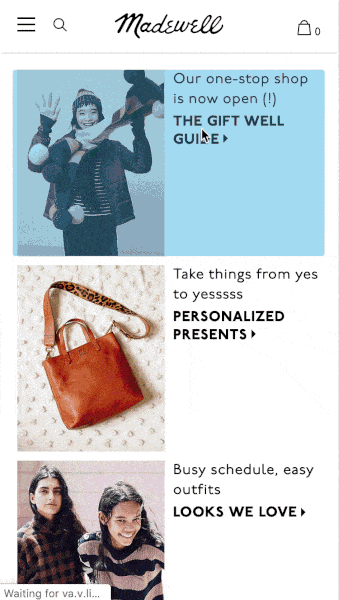
Madewell has specific categories in its navigation menu and provides a seamless way to navigate other categories.
A popular way to publish a gift guide is as a blog, and one way to present your products better is by following a listicle format. Provide more details about each of the products and categories and link to the appropriate product pages.
If you have resources to spare, consider creating a video gift guide or partnering with an influencer to promote your gift guide, which can help in traffic and engagement. If you have limited resources, consider creating videos using Instagram reels and TikTok.
If you want a personalized recommendation (and to prevent losing a potential buyer due to scrolling too much on your holiday gift guides), why not try letting them take a short quiz where you can find out their preferences—budget, gift type, etc. The results page is a curated gift guide based on their answers.
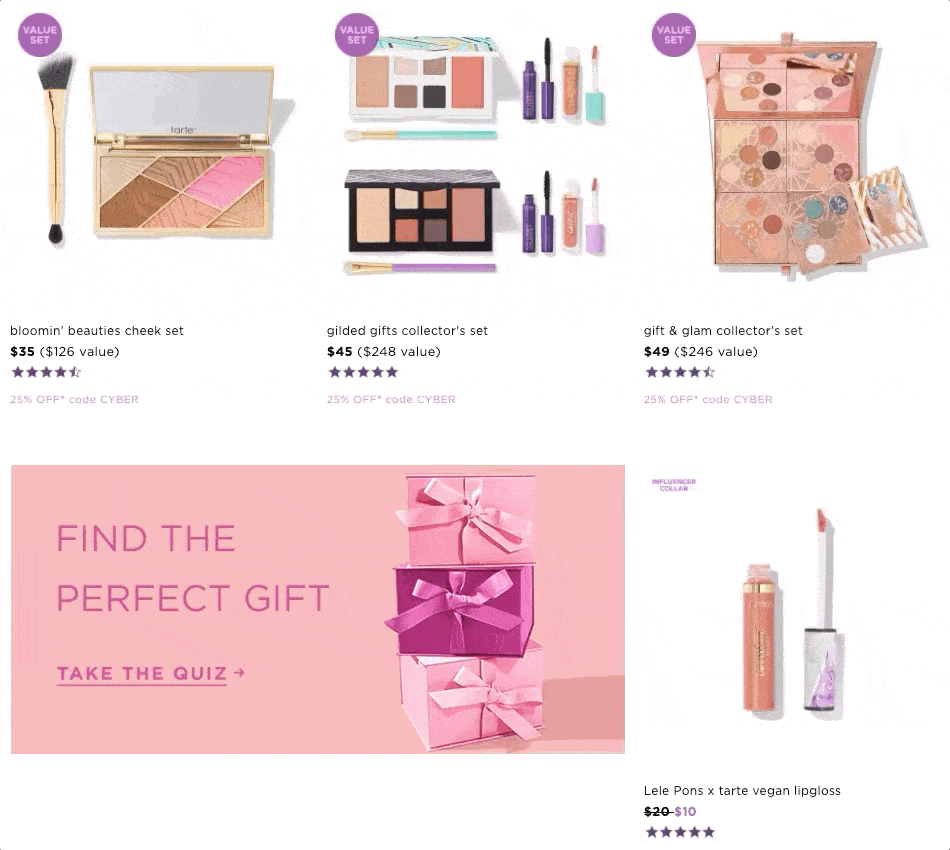
Tarte prominently displays its quiz on its online store by utilizing a GIF and making the quiz stand out in a different color.
Step 5: Design Your Holiday Gift Guide
After you decide on the format of your holiday gift guides, the next step is to design them. You must present your products in a way that evokes emotion and inspires customers to action (i.e., to shop). Remember that gift buying is an emotion-driven venture for shoppers—so use words and photos effectively.
Use Catchy Headlines
Gift guide headlines should speak directly to the customer. A well-written one hooks your target audience and entices them to browse.
- Use active voice (“Find the perfect gift”)
- Use power words (“Unwrap delight with our hand-picked treasures”)
- Describe products in a way that they can see the benefits (“Pamper your loved ones with a relaxing spa experience”)
Use High-quality Product Photos
The quality of your product photos has a massive impact on how your audience perceives your merchandise. Master DIY product photography if you need to save on resources.
Design With an Omnichannel Perspective
When designing your gift guides, remember the following:
- Digital gift guides should be responsive.
- Make sure it looks great on all channels—website, social media, and email campaigns.
- The layout should be clean—with some amount of empty space—to avoid overwhelming customers. Learn how to create landing pages that convert.
Step 6: Promote Your Holiday Gift Guides
Now that you have created your holiday gift guides, it’s time to ensure they reach the right people. It’s always best to combine physical and digital retail approaches to ensure your marketing campaigns have maximum impact and reach a broader market.
TIPS:
- Start promoting early. Almost half of consumers started their holiday shopping before November in 2022, and 33% planned to start even earlier this year.
- Include Buy Now, Pay Later promos in your holiday gift guides. BNPL generated $6.4 billion in online spending in October and is expected to surge during Black Friday Cyber Monday (BFCM). Learn how to offer customer financing in five steps.
Here are some ways to help you market your gift guide to the right audience.
Send Gift Guides by Email
Email is still one of the most effective marketing methods available. According to a widely reported stat, email gets you nearly 40 times more customers than Facebook and Twitter combined. Most people on your list are more likely interested in what you have to offer, so the chances of purchasing are high. You can also create personalized campaigns by segmenting your list and sending them personalized gift guides to increase the chances of conversion.
Sending a series of email campaigns promoting your holiday gift guide will likely increase conversions. Some ideas for email marketing campaigns include:
- Highlighting holiday shopping information and deadlines
- Showcasing particular products from the gift guide
- Showing gift guides by price or budget and persona-based gift guides
- Mentioning different payment options and additional services such as gift wrapping
- Sharing customer reviews
- Indicating sale or limited-time offer in subject line
- Including last-minute gift ideas
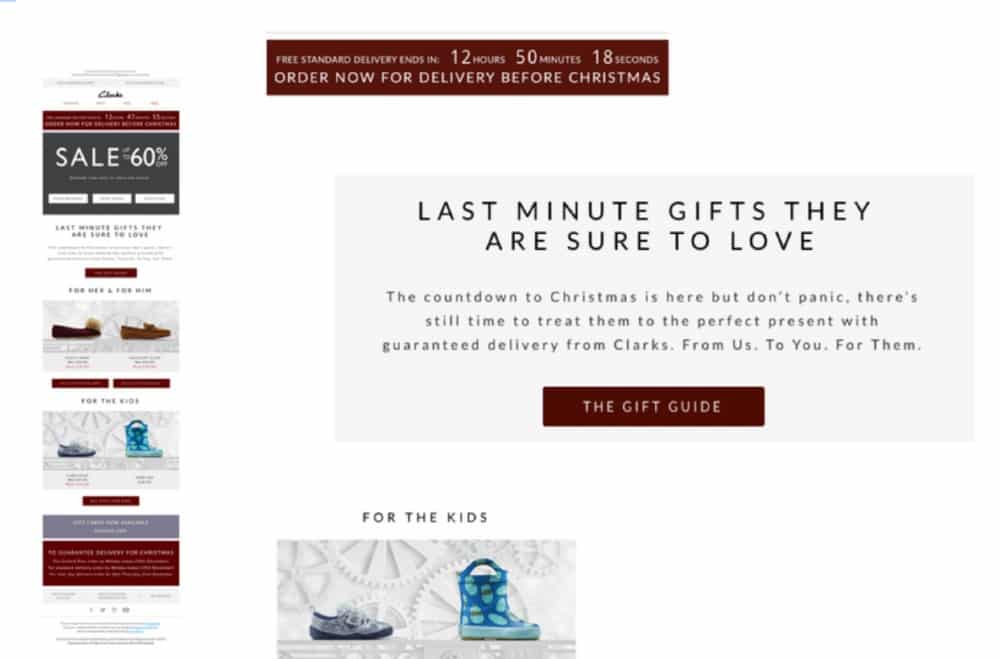
Clark’s sent this email to its list with the subject line: “SALE Now Up To 60% Off | FREE Standard Delivery Ends Tonight”
Share on Social Media
Forty-three percent of consumers use social media to find products, and holiday shopping won’t be any different. In fact, when asked which social media platforms they look to for inspiration during holiday shopping, US consumers most frequently chose Facebook, followed by YouTube and then Instagram.
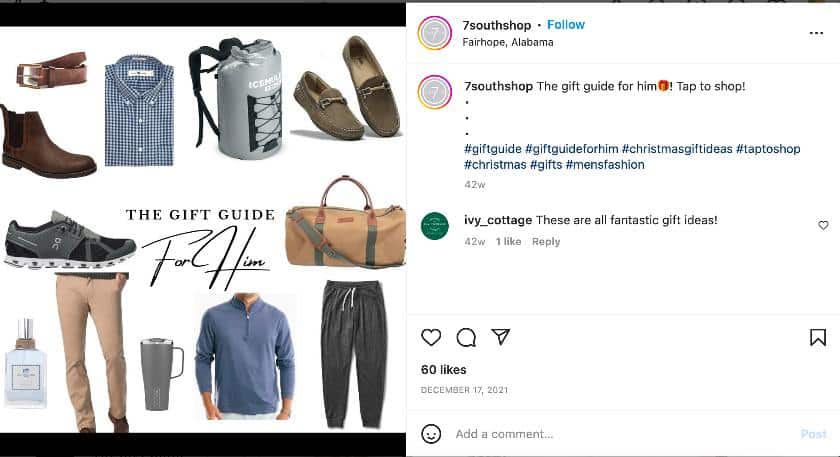
7SouthShop curated their products by category (in this case, gender). Note that their caption encourages viewers to “tap to shop.” Create shoppable posts on Instagram to make it easier for customers to purchase.
Apply SEO Strategies
Make it easy for your customers to find your holiday gift guides by implementing an effective SEO (search engine optimization) strategy. For a detailed rundown, read our ultimate SEO for ecommerce beginner’s guide.
SEO plays a big part in retail marketing—even if you operate a brick-and-mortar store. For example, implementing local SEO strategies helps you get discovered within your community. You don’t have to implement a full-blown SEO marketing campaign with paid ads if you are not versed in it yet. Just remember the fundamentals of SEO and execute the following best practices:
- Do keyword research
- Add tags to your images
- Utilize strategic linking
- Focusing on user experience (make website pages mobile-responsive, have your store show up in Google Maps, etc.)
Collaborate With Other Businesses & Influencers
Check in with other local retail business owners and ask if they want to collaborate on creating a holiday gift guide and promoting it. You add more options for your customers and increase your store’s exposure by tapping into other businesses’ audiences.
- Partner with businesses that have a similar target audience. For example, if you sell women’s beauty products, teaming up with a spa, fitness gym, or yoga studio could be a good combination.
- Partner with an influencer to help promote your gift guide if you are doing online promotions. Start brand awareness campaigns by way of hashtags and encourage user-generated content (UGC).
Step 7: Offer a Variety of Fulfillment Options for Holiday Gift Guide Purchases
According to a Think with Google study, only 4% of US holiday shoppers did not use digital channels for their shopping in 2021. The boundaries between online and offline shopping are merging, with convenience being the main factor in deciding how and where people shop.
Make sure to reflect your in-store products online (and have accurate inventory) and offer a range of delivery and collection options to make the purchasing experience as seamless as possible.
- Learn how to set up click and collect (buy online, pickup in-store)
- Offer free shipping (without losing money)
- Find the best shipping carrier to offer expedited delivery options
- Provide real-time tracking for all orders with shipping software
- Offer local delivery services for nearby customers
Benefits of Holiday Gift Guides
Gift guides serve as a strategic tool to help both your business and your customers during the holiday shopping season. Here are some of the ways that learning how to create a retail gift guide benefits your store:
- Targeted Marketing: Creating a holiday gift guide allows you to showcase a precise selection of products, directly reaching specific customer groups. This focused approach boosts marketing effectiveness by aligning with different buyer preferences.
- Increased Sales: By spotlighting select items, gift guides can steer customers toward overlooked products and help convey each item’s value, often leading to more conversions and higher sales.
- Improved Customer Experience: Simplifying the shopping process (especially for unsure gift-givers and last-minute holiday shoppers) enhances overall satisfaction. Gift guides streamline a customer’s options, making the experience more enjoyable and less overwhelming.
- Brand Visibility: Attractive and helpful gift guides are likely to be shared, increasing your brand’s exposure and reach (especially on social media)
- Online Traffic Boost: Gift guides can significantly increase traffic to your online store, enhancing your digital presence and leading to continued, post-holiday sales.
- Competitive Advantage: Offering a thoughtfully curated shopping experience sets your business apart, showcasing your brand as more customer-focused than competitors.
- Inventory Management: Gift guides can be a way to strategically move specific inventory—especially seasonal items—optimizing stock levels and minimizing surplus.
Frequently Asked Questions (FAQs)
Here are some of the most common questions about creating a retail gift guide.
A holiday gift guide is a selection of products, put together by a retailer or a reviewer, designed to suggest gift ideas. They’re typically available online or in print (such as a blog post or flyer). Holiday gift guides aim to make finding presents easier for shoppers looking for specific categories—such as gifts for co-workers, family, or friends with particular interests.
An example of a holiday gift guide is an online catalog on an ecommerce site, presenting a range of gift ideas. It could organize products by recipient (e.g., “Gifts for Him”), theme (“Gifts for a Tech Enthusiast”), or price (“Gifts Under $50”). These guides typically include attractive images, product details, and direct links for easy browsing and buying.
The purpose of a gift guide is to aid in decision-making, boost sales, enhance brand visibility, and improve the overall customer shopping experience, especially during the holiday season.
Bottom Line
Learning how to create a retail gift guide is a must—whether it’s a brick-and-mortar shop or an ecommerce store. Holiday gift guides attract high-intent shoppers (those who are actively looking to buy something), boost sales revenue, and promote your brand.
When creating a holiday gift guide, ensure it’s effective as a marketing strategy by making it well-crafted, personalized for your audience, and strategically distributed so that it can reach your market at the right time.
